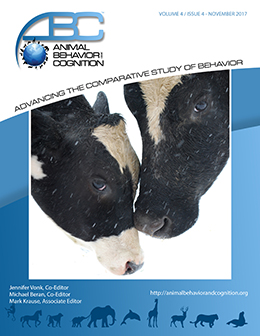Vol 4, Issue 4, November 2017
Visual Discrimination Learning in the Jumping Spider Phidippus regius
Citation
De Agrò, M., Regolin, L., & Moretto, E. (2017). Visual discrimination learning in the jumping spider Phidippus regius. Animal Behavior and Cognition, 4(4), 413-424. https://dx.doi.org/10.26451/abc.04.04.02.2017
Abstract
Over the past decade, research in comparative psychology has increasingly focused on non-vertebrate models of cognition. Jumping spiders provide excellent models for the study of visually mediated behaviors, such as associative learning or the navigation of complex environments. Here, we tested visual and memory abilities of Phidippus regius to discriminate between artificial geometrical stimuli and to generalize the learned discrimination to illusory stimuli, using the amodal completion mechanism. Spiders were first trained to associate one shape (‘X’ or ‘O’) with a reward (sugar water), whilst the other shape was associated with an aversive taste (acidic water). Spiders were then asked to choose between the two shapes in the absence of any reward or punishment. They were then presented with an occluded version of the previously rewarded shape to test for the presence of amodal completion. Spiders were able to learn the discrimination task, although the association was not transferred to the illusory stimulus. This study provides the first demonstration of shape discrimination learning in a jumping spider. The results of the test on the illusory shape are discussed considering that either the spiders' visual system may not require amodal completion or they could have the tendency to learn the shape associated with the aversive taste rather than that associated with the reward.
Key words
Jumping Spiders, Salticidae, Phidippus regius, Visual illusion, Amodal completion, Visual discrimination learning
